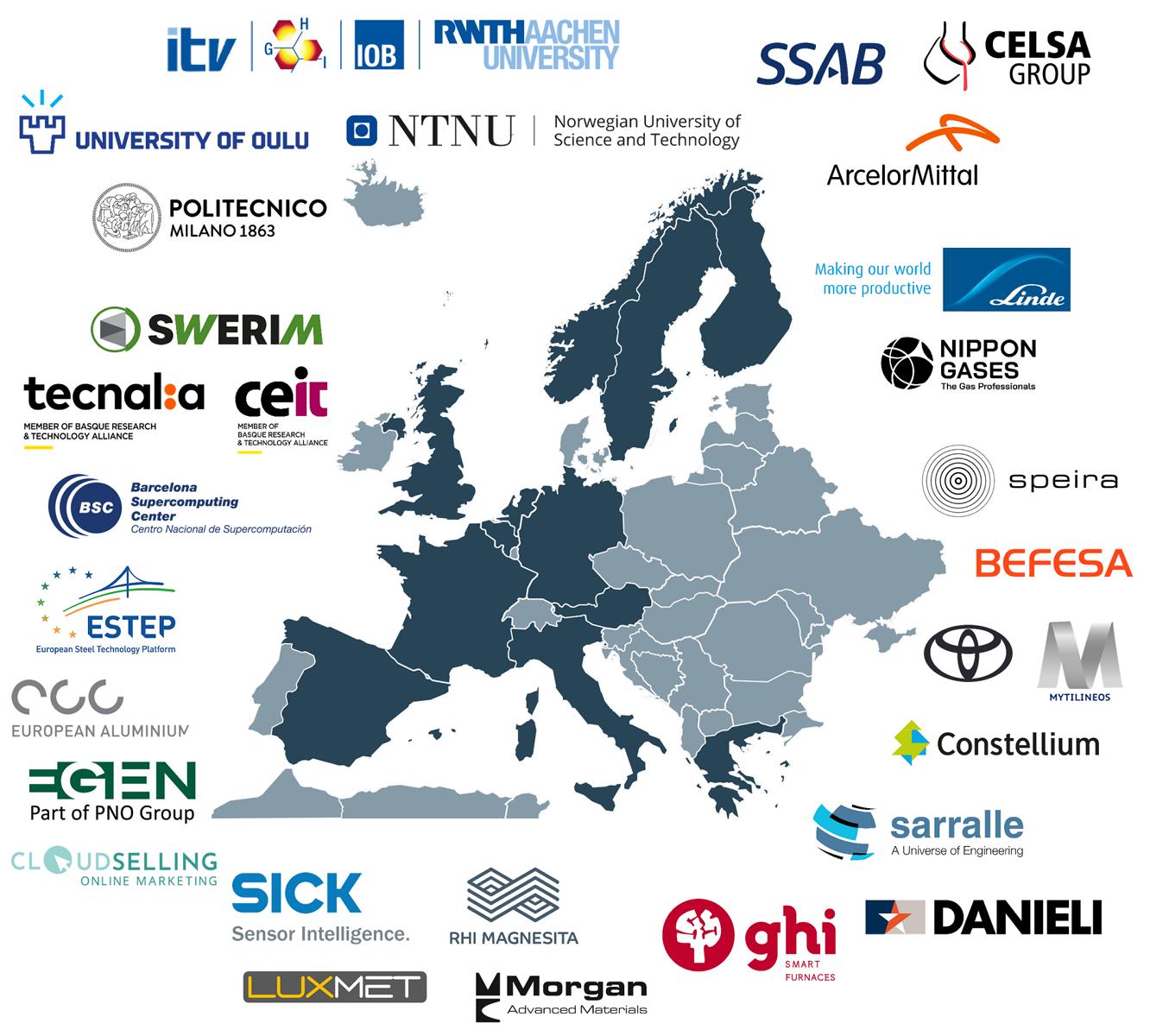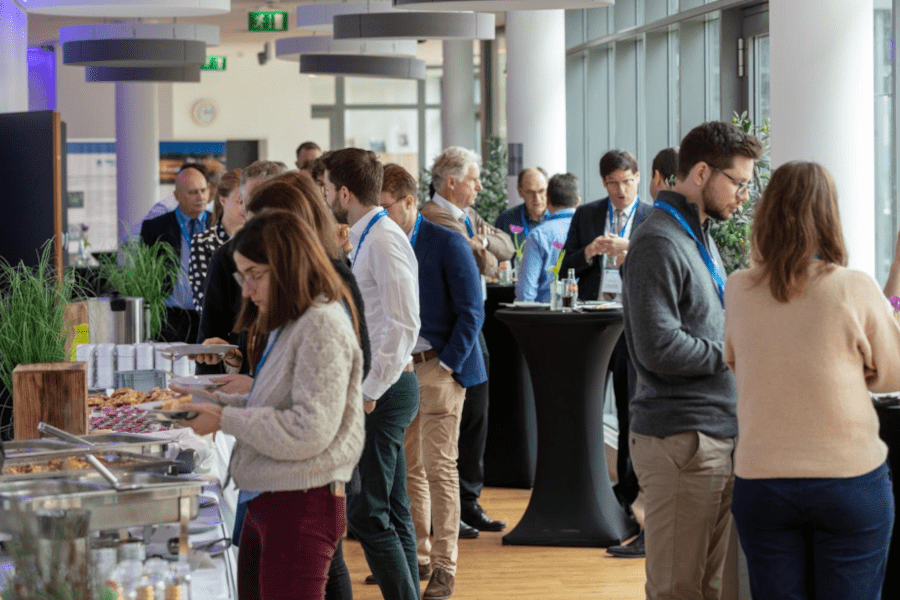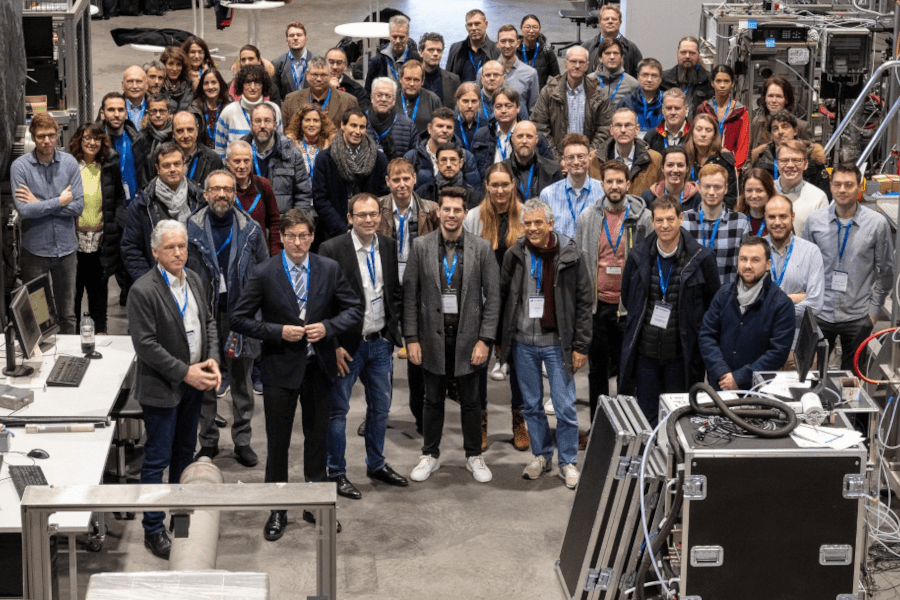With HyInHeat — Hydrogen technologies for decarbonisation of industrial heating processes a large-scale project with 28 partners from 12 European countries, coordinated by the Department for Industrial Furnaces and Heat Engineering (IOB) started. The kick-off meeting finally took place in Aachen at the end of January.
The consortium around the IOB has set itself the goal of demonstrating the use of hydrogen as fuel in the high-temperature processes of the steel and aluminium industry. Especially in the energy-intensive processes of melting and heat treatment, the replacement of fossil fuels with green hydrogen holds great potential to decrease CO2 emissions of industrial processes. In order to take account of the fact that large quantities of green hydrogen are not yet widely available, the operation in a fuel mix of natural gas and hydrogen up to pure hydrogen is being investigated. Another focus is on combustion with pure oxygen, which is a secondary product of green hydrogen production via electrolysis and enables an increase in combustion efficiency.

The project is located in the Technology Readiness Level (TRL) 3 to 7 and thus incorporates the development stages from experimental technology development to prototypes in an industrial environment. Within this framework, eight furnaces will be converted on a pilot and industrial scale and the respective processes will be investigated in detail. The project, which is part of the Horizon Europe funding programme, runs under the umbrella of the Processes4Planet Partnership. The corresponding EU-funding is 17.7 million euros, the total cost of the project is almost 24 million euros.
For the kick-off meeting on the 31st of January and the 1st of February 2023, the IOB invited the project partners to the Forum M in Aachen to get to know each other in person for the first time: At the beginning, Thomas Echterhof as project coordinator welcomed the approximately 80 participants. After the introductory greetings by Prof. Herbert Pfeifer, Nico Schmitz gave an overview of the content of the project. The responsible EU Project Officer then took the floor, followed by representatives of A.SPIRE and the Clean Hydrogen Partnership. Afterwards, each partner had the chance to introduce themselves to the consortium in short presentations. The late afternoon was devoted to an introduction to the first work package. After a short break, there was a guided tour of Aachen’s historic old town followed by dinner at Ratskeller. The second day started with visits to the IOB and the Institute of Mineral Engineering (GHI). From noon onwards, the content of the project was in focus again and the remaining work packages were discussed, accompanied by many discussions and conversations in the generously laid out breaks.
The partners from 12 European countries include ArcelorMittal, Celsa Group and SSAB, three steel producers, and Befesa, Constellium, Mytilineos and Speira from the aluminium sector. The automotive industry is represented by Toyota. Linde and Nippon Gases act as gas suppliers and technology providers, and furnace manufacturers Danieli, GHI Hornos and Sarralle also contribute with their technical expertise. Industrial competence in the refractory sector is represented by RHI Magensita and Morgan Advanced Materials, and in the field of measurement technology SICK and Luxmet support the other project partners with their know-how. The European associations ESTEP and European Aluminium contribute with the collection and provision of data for scenario analyses and help with the dissemination of the results. As an expert in European projects, EGEN and its online marketing partner Cloudselling will also provide significant support to the consortium in publishing the results.

With Tecnalia, Ceit, SWERIM and the Barcelona Supercomputing Center, four research institutions are represented. From academia, in addition to the University of Oulu, the Norwegian NTNU and the Politecnico de Milano, RWTH Aachen University is represented by three departments. The Institute of Mineral Engineering (GHI) is dedicated to refractory furnace materials. Samples from the industrial plants as well as newly developed materials are examined for their interaction with the new furnace atmospheres, which change in terms of temperatures and atmosphere compared to combustion with natural gas. Following a series of experiments in the institute’s own spherical combustion chamber, the Institute for Combustion Technology (ITV) provides the kinetic reaction mechanism for hydrogen combustion, which maps the combustion reactions in subsequent CFD simulations. Together with the Barcelona Supercomputing Center, a methodology for the large-eddy simulation (LES) of hydrogen combustion is being developed, by means of which the flame dynamics can be predicted under given operating conditions.
In addition to the project coordination, IOB also contributes to the specific work packages of the project. For example, the influence of impurities in the fuel on the instrumentation of the gas supply and the burner operation is being tested in the in-house technical centre. The changed conditions in the flue gas due to the increased water content are analysed with regard to the necessary adjustments in the field of emission measurement technology. The conventional measurement of nitrogen oxide emissions in dry exhaust gas must be critically questioned in this context, so that alternative measurement principles will be evaluated. In the area of modelling and simulation, the activities focus on the modeling of single burners as well as entire furnaces, including the products and peripheral plant components. In addition to direct heating in melting furnaces for the aluminium industry and heating furnaces for hot forming of steel, indirect heating with radiant heating tubes is also being investigated. For the simulation, the increased water content in the flue gas results in different conditions compared to natural gas, so that suitable models for radiant heating are evaluated. A reasonable numerical effort is achieved by Reynolds Averaged Navier Stokes (RANS) simulations, which are solved on the partly newly created server capacities at the IOB. The methodology is validated against the accurate LES simulation results and data from the laboratories and industry demonstrators. The simulations support the design of burners, furnace processes and the conversion of existing plants to run on hydrogen. In parallel, the life cycle assessments of the processes and products are continuously evaluated to ensure the achievement of the overall project goal: To make a major contribution to the decarbonisation of the steel and aluminium industry.

Funded by the European Union. Views and opinions expressed are however those of the author(s) only and do not necessarily reflect those of the European Union or the European Health and Digital Executive Agency (HADEA). Neither the European Union nor the granting authority can be held responsible for them.
 |
 |
Contact person
Dr.-Ing. Thomas Echterhof, project coordinator and academic director
Department for Industrial Furnaces and Heat Engineering of RWTH Aachen University
Kopernikusstr. 10
52074 Aachen GERMANY
+49 241 80–25958
echterhof@iob.rwth-aachen.de

